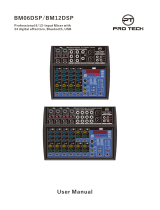
8
SIGNAL LEVELS AND THE DECIBEL
Let’s take a look at one of the most commonly used units in
audio: the decibel (dB). If the smallest sound that can be
heard by the human ear is given an arbitrary value of 1, then
the loudest sound that can be heard is approximately
1,000,000 (one million) times louder. That’s too many digits
to deal with for practical calculations, and so the more
appropriate “decibel” (dB) unit was created for sound-related
measurements. In this system the difference between the
softest and loudest sounds that can be heard is 120 dB. This
is a non-linear scale, and a difference of 3 dB actually results
in a doubling or halving of the loudness.
You might encounter a number of different varieties of the
dB: dBu, dBV, dBM and others, but the dBu is the basic
decibel unit. In the case of dBu, “0 dBu” is specified as a
signal level of 0.775 volts. For example, if a microphone’s
output level is -40 dBu (0.00775 V), then to raise that level to
0 dBu (0.775 V) in the mixer’s preamp stage requires that the
signal be amplified by 100 times.
A mixer may be required to handle signals at a wide range
of levels, and it is necessary to match input and output levels
as closely as possible. In most cases the “nominal” level
for a mixer’s input and outputs is marked on the panel or
listed in the owner’s manual.
TO EQ OR NOT TO EQ
In general: less is better. There are many situations in which
you’ll need to cut certain frequency ranges, but use boost
sparingly, and with caution. Proper use of EQ can eliminate
interference between instruments in a mix and give the
overall sound better definition. Bad EQ—and most
commonly bad boost—just sounds terrible.
Cut for a Cleaner Mix
For example: cymbals have a lot of energy in the mid and
low frequency ranges that you don’t really perceive as
musical sound, but which can interfere with the clarity of
other instruments in these ranges. You can basically turn the
low EQ on cymbal channels all the way down without
changing the way they sound in the mix. You’ll hear the
difference, however, in the way the mix sounds more
“spacious,” and instruments in the lower ranges will have
better definition. Surprisingly enough, piano also has an
incredibly powerful low end that can benefit from a bit of
low-frequency roll-off to let other instruments—notably drums
and bass—do their jobs more effectively. Naturally you won’t
want to do this if the piano is playing solo.
The reverse applies to kick drums and bass guitars: you can
often roll off the high end to create more space in the mix
without compromising the character of the instruments. You’ll
have to use your ears though, because each instrument is
different and sometimes you’ll want the “snap” of a bass
guitar, for example, to come through.
+ 20 dBu
0 dBu
0.775 V
– 20 dBu
– 40 dBu
– 60 dBu
Most professional mixers, power
amplifiers, and other types of equip-
ment have inputs and outputs with a
nominal level of +4 dBu.
The inputs and outputs on home-use
audio gear usually have a nominal
level of –7.8 dBu (–10 dBV).
Microphone signal levels vary over a
wide range depending on the type of
microphone and the source. Average
speech is about –30 dBu, but the
twittering of a bird might be lower
than –50 dBu while a solid bass drum
beat might produce a level as high as
0 dBu.
Some Frequency Facts
The lowest and highest frequencies than can be heard by the human
ear are generally considered to be around 20 Hz and 20,000 Hz,
respectively. Average conversation occurs in the range from about
300 Hz to about 3,000 Hz. The frequency of a standard pitchfork
used to tune guitars and other instruments is 440 Hz (this
corresponds to the “A3” key on a piano tuned to concert pitch).
Double this frequency to 880 Hz and you have a pitch one octave
higher (i.e. “A4” on the piano keyboard). In the same way you can
halve the frequency to 220 Hz to produce “A2” an octave lower.
20 50 100 200 500 1 k 2 k 5 k 10 k 20 k
(Hz)
The fundamental and harmonic frequency ranges of some musical instruments.
PIANO
BASS DRUM
SNARE DRUM
BASS
GUITAR
TROMBONE
TRUMPET
CYMBA 1
Fundamental: The frequency that determines the basic musical pitch.
Harmonics: Multiples of the fundamental frequency that play a role in determining
the timbre of the instrument.





















